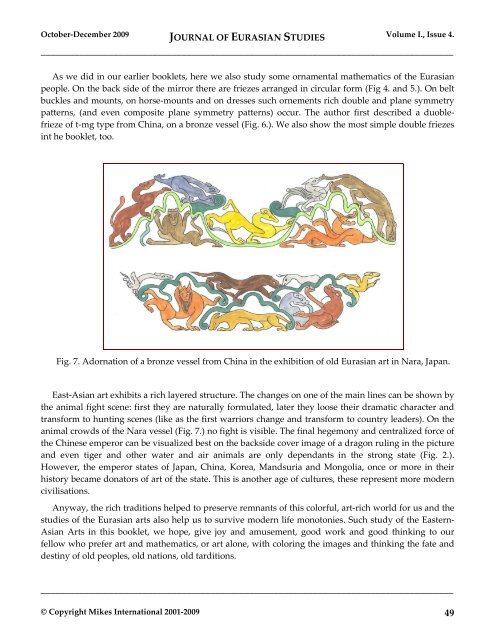JOURNAL OF EURASIAN STUDIES
JOURNAL OF EURASIAN STUDIES
JOURNAL OF EURASIAN STUDIES
You also want an ePaper? Increase the reach of your titles
YUMPU automatically turns print PDFs into web optimized ePapers that Google loves.
October-December 2009 <strong>JOURNAL</strong> <strong>OF</strong> <strong>EURASIAN</strong> <strong>STUDIES</strong> Volume I., Issue 4.<br />
_____________________________________________________________________________________<br />
As we did in our earlier booklets, here we also study some ornamental mathematics of the Eurasian<br />
people. On the back side of the mirror there are friezes arranged in circular form (Fig 4. and 5.). On belt<br />
buckles and mounts, on horse-mounts and on dresses such ornements rich double and plane symmetry<br />
patterns, (and even composite plane symmetry patterns) occur. The author first described a duoblefrieze<br />
of t-mg type from China, on a bronze vessel (Fig. 6.). We also show the most simple double friezes<br />
int he booklet, too.<br />
Fig. 7. Adornation of a bronze vessel from China in the exhibition of old Eurasian art in Nara, Japan.<br />
East-Asian art exhibits a rich layered structure. The changes on one of the main lines can be shown by<br />
the animal fight scene: first they are naturally formulated, later they loose their dramatic character and<br />
transform to hunting scenes (like as the first warriors change and transform to country leaders). On the<br />
animal crowds of the Nara vessel (Fig. 7.) no fight is visible. The final hegemony and centralized force of<br />
the Chinese emperor can be visualized best on the backside cover image of a dragon ruling in the picture<br />
and even tiger and other water and air animals are only dependants in the strong state (Fig. 2.).<br />
However, the emperor states of Japan, China, Korea, Mandsuria and Mongolia, once or more in their<br />
history became donators of art of the state. This is another age of cultures, these represent more modern<br />
civilisations.<br />
Anyway, the rich traditions helped to preserve remnants of this colorful, art-rich world for us and the<br />
studies of the Eurasian arts also help us to survive modern life monotonies. Such study of the Eastern-<br />
Asian Arts in this booklet, we hope, give joy and amusement, good work and good thinking to our<br />
fellow who prefer art and mathematics, or art alone, with coloring the images and thinking the fate and<br />
destiny of old peoples, old nations, old tarditions.<br />
_____________________________________________________________________________________<br />
© Copyright Mikes International 2001-2009 49
















